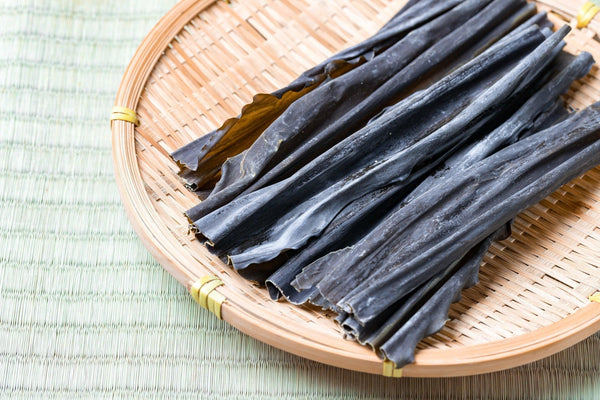
Jump to:
Although to many people in the West, seaweed may be just the vegetation you try to avoid becoming entangled in when swimming in the sea, seaweed is a really important part of the Japanese diet. Edible seaweed in Japan comes in many forms, including Wakame, Nori, and Kombu, which is the subject of this article. (See this article for a general overview of the different seaweed types.)
In this blog post, we shall look at what Kombu is, where and how it is harvested in Japan, consider its health benefits and the way it is used in Japanese cooking, compare it to some other types of seaweed, look at different ways of consuming it, and round off by looking at where to get it, exploring some major brands you might like to try.
What Is Kombu?

Simply put, Kombu is a type of edible kelp. It is eaten in its original form in many dishes but also serves as a stock base. It contains glutamic acid, which gives umami to dishes. It is characterized as being a lot thicker than other forms of seaweed and contains a double layer. These two outer layers function like an envelope and mean that other ingredients can be cooked between the layers.
The thickness of Kombu is largely determined by its age. First-year Kombu is thinner (in taste as well), whereas Kombu harvested in its second year is much thicker. This is called Ma-Kombu (literally “true Kombu”) and because of its enhanced flavor, it tends to be preferred for making Dashi stock in the more up-market restaurants.
Where And How Is Kombu Harvested?

More than 90% of the Kombu produced in Japan comes from Hokkaido, with the remainder coming from three prefectures in the Tohoku region: Aomori, Iwate, and Miyagi. The reason for this northern bias in its production is due to the fact that coastal regions with cold seawater are the ideal habitat for Kombu to grow.
In its most commonly harvested form, Kombu is an excellent renewable resource. Generally, only the “top leaf” part of the plant is taken. By leaving the root of the Kombu as is, the plant is able to regrow. The exception to this is a type of seaweed called Ne-Kombu (literally “root kelp”), which involves harvesting and eating the whole root. This is also delicious and packed with nutrients, but obviously has drawbacks in terms of renewability.
Main Types Of Kombu
This might be a good point to introduce some of the main types of Kombu.
Tororo-Kombu

Tororo-Kombu is a type of Kombu that is soaked in vinegar for a day before being machine-shaved into fine flakes before being dehydrated. Soy sauce and boiling water can be added to make a tasty soup, and it is commonly used with Onigiri rice balls and in clear soups.
Oboro-Kombu

While Tororo-Kombu is normally produced by a machine to make fluffy threads, Oboro-Kombu is produced manually through skilled labor using high-grade Kombu to make thin sheets of Kombu. The extra effort required is reflected in its higher price
Shio-Kombu

Shio-Kombu is processed into thin short strips after the Kombu is simmered down using soy sauce and salt. In this way, it differs from the two types mentioned above, which are normally unseasoned.
Shiroita-Kombu

Shiroita Kombu are white Kombu sheets that are planed by hand, and soaked in spirit vinegar for a whole day.
Shredded Kombu

As the name suggests, this is Kombu that has been shredded and can be used straight out of the packet for use in salads, mixed into rice, used with Onigiri rice balls, or Ochazuke.
Are Kombu And Seaweed The Same Thing
Although all Kombu is seaweed, not all seaweed is Kombu. Let us consider how Kombu differs from the two other main types of seaweed used in Japanese cooking – Wakame and Nori.
Kombu vs Wakame

Kombu and Wakame are completely different in appearance. Kombu grows in a single strip, whereas wakame grows with spreading leaves. They are also very different in the way they are used in cooking. Kombu is used to add a salty, umami taste to food whereas Wakame has a milder, more plain taste and it utilizes other flavors around it, such as vinegar or salt.
Kombu vs Nori

Unlike Kombu which, in addition to being eaten as is, provides flavors to soups and stews, Nori is dried and rolled into sheets, and typically used to wrap rice and fish, as in Makizushi. For more information on Nori, see this article.
Health Benefits Of Kombu
Kombu is a true nutritional powerhouse. It is rich in a number of vitamins including B1 and B2, which help to relieve fatigue and provide mental clarity. Combining this with blue fish and other foods high in DHA, promise to help preserve your memory capabilities.
Calcium is very important for people of all age groups, especially growing children, pregnant women, and the elderly with fragile bones. The good news is that Kombu is packed with the stuff (approximately seven times more than milk).
Another major benefit of Kombu is its high levels of iodine. Iodine is the raw material for thyroid hormones and moderate intake of iodine is known to stimulate the secretion of thyroid hormones and make their function more active, thus preventing fatigue, promoting human growth, and regulating the metabolism.
Other benefits include fiber for aiding digestion and slowing down the absorption of sugar, alginic acid that helps to efficiently remove sodium from the body and thus regulates blood pressure, and its anti-allergic components. The umami of Kombu also means that you naturally do not need to use as much salt in your cooking to give it taste. What is more, all of these health benefits are provided with only healthy fats and at a low calorie and glycemic index count.
Too Much Of A Good Thing?
It should be clear from what has been said above that your body will thank you for including Kombu in your diet. As with most things in life, however, you can get too much of a good thing. While Kombu is extremely healthy, you should eat it only in moderation.
The fiber and iodine content of Kombu provides many benefits for your health, but over-consumption of soluble fiber, which is an indigestible substance, can cause indigestion and dietary small bowel obstruction, where food can get stuck in the digestive tract, causing nausea and abdominal pain. In extreme cases, surgery may be required to remove it.
Overconsumption of iodine can bring similar symptoms to deficiency. It can cause thyroiditis (inflamed thyroid), which will stop your thyroid from producing thyroid hormone. You should pay particular attention to this if you are keen on snacks such as Oshaburi-Konbu, which provide Kombu in dried form and can easily be over-consumed. It is probably best to avoid eating more than 10 g of Oshaburi-Konbu or around 5-6 cm of other Kombu per day.
Ways To Enjoy Kombu?
If you spend any length of time in Japan, you are bound to encounter Kombu sooner rather than later as it is used in a wide range of forms. A few representative examples of these are given below.
Oden

Oden is a popular winter-warmer dish in Japan that you can find not only in restaurants but also in take-away form, bubbling away near the cash register in convenience stores. Kombu typically presented like a tied-up bow is a mainstay of this dish, particularly in its Tokyo incarnation. You can find more information on Oden in this article.
Kombu Tsukudani

Kombu Tsukudani is an excellent way of using any leftover Kombu you have to make a delicious and healthy side dish for rice. It is made by boiling the Kombu in a seasoning solution consisting of Shoyu, sugar, salt, and Mirin. When the Kombu is boiled in this way(100-120°C), it softens and swells, and the Kombu absorbs the flavors of the seasoning solution. You can learn how to make it at home in this recipe.
Furikake

Another common use of Kombu as an accompaniment to rice is Furikake, which is an all-purpose seasoning that you sprinkle on rice. One advantage of Furikake is that as long as you have a bowl of rice, you can prepare a simple meal with no preparation at all. Although it can be purchased reasonably inexpensively in supermarkets in Japan, if you are feeling adventurous, this post will show you how to make your own.
Kombu-Maki

Kombu-Maki, or Kombu rolls, are a dish in which fish and other ingredients are served wrapped in Kombu. Not only is this dish delicious, but it also combines the DHA of the fish with the B vitamins of the Kombu and this benefits your brain in a two-fold way.
Dashi

Dashi, or soup stock, is a mainstay of Japanese cuisine, that forms the basis of many stews, soups, and sauces. Alongside bonito, Kombu is one of the main ingredients, providing its trademark umami flavor. Check out this article for everything you need to know about Dashi.
Konbucha

Konbucha (with an “n”) is a delicious and healthy tea made from dried Kombu. This can be enjoyed either in plain form or flavored with Ume(Japanese plum). When purchasing it, however, be aware that there is something with a similar name (“Kombucha”) that is a completely different product. Not to worry, however, as this post will clarify everything.
Where Can I Buy Kombu?
You can purchase Kombu in both fresh and dried form in most supermarkets. There is a lot of choice out there, however, and you may be a little confused about where to start your Kombu journey.
This J-Taste Hidaka Kombu is a great place to start. It hails from the Hidaka subprefecture of Hokkaido, which is a famous area for producing Kombu, and this umami-rich product, with its soft texture and mellow, rich flavor profile can be easily added to create Dashi or used in a wide range of other dishes.
There is also a wide range of Kombu snacks available from the Japanese Taste website, including these Kombu-flavored wheat gluten snacks, and Izuri produces Konbucha, as well as a wide range of ready-made Dashi products.
Kombu -The Versatile And Healthy Seaweed

As discussed, Kombu is a really important ingredient in Japanese cooking. In addition to playing a starring role in Dashi, which forms the basis for a host of different soups, stews, and sauces, it is also used as a low-cost, virtually calorie-free accompaniment to rice and rice balls, as well as being a primary ingredient in Oden.
It also has a whole host of nutritional benefits, and provided it is eaten in moderation, can make a real contribution to a healthy lifestyle.
Are you a fan of Kombu? Let us know in the comments.


1 comment
Thank you.
Great article.
Thorough, fun, helpful
Jackie,